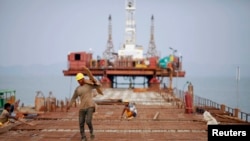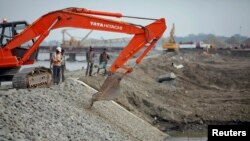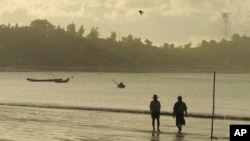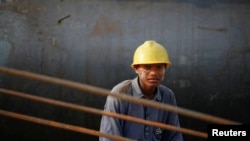India helped inaugurate a long-awaited seaport in western Myanmar this month amid New Delhi’s efforts to cope with rival China’s growing influence in Southeast Asia and across the Indo-Pacific.
A maiden delivery of 1,000 metric tons of cement from the Indian metropolis of Kolkata docked May 9 in Sittwe, Myanmar, at a new port funded by New Delhi.
The Sittwe port is the first node in the $484 million Kaladan Multi-Modal Transit Transport Project, aimed at connecting greater India with its landlocked northeast through western Myanmar’s Rakhine and Chin states, bypassing Bangladesh.
In a statement, India’s Ministry of Ports, Shipping and Waterways said the Sittwe port would herald “a new age of transportation” with Myanmar and “unlock tremendous economic potential” across the region by bridging South and Southeast Asia. Once completed with a 158-kilometer shipping route up the Kaladan River from Sittwe and another 210 kilometers of road leading back into India, the ministry said the corridor would slash transport times and costs between Kolkata and Mizoram state by more than half.
India and Myanmar shook hands on the project 15 years ago, but it actually stems from goals of plugging India’s economy into the bustling markets of Southeast Asia dating back to the 1960s, Avinash Paliwal, a senior lecturer at Britain’s School of Oriental and African Studies told VOA.
“This is the larger aspiration, which has always been couched in terms of the Look East or Act East policy of India. And today it is also being made ... an important element of India’s Indo-Pacific approach and to counter China, because this is a region where China has also been dominant,” he said.
Balancing China
Paliwal said concern over China’s growing sway in the region is an “article of faith” for India, even if it has never invested the money into pushing back with much force. Compared with China, he added, India has also done relatively little to cultivate the ethnic-minority rebel armies that control much of Myanmar’s borderlands, Rakhine and Chin included.
Even if China continues to dominate relations with Myanmar, Paliwal said India’s investment in the Sittwe port at least helps to keep it in the good graces of the military regime that seized power in 2021.
“The bottom line is India’s main idea is to make sure the channels with the junta remain open, because they need to know what the Chinese are doing. The intelligence pipeline needs to be open,” he said. “If throwing some money on the Kaladan helps them keep that pipeline open, that’s fine for them.”
If and when it is finished, the corridor could give India an important economic boost too, Sreeparna Banerjee, a junior fellow at the Observer Research Foundation think tank based in Kolkata, told VOA.
By connecting India’s northeast to the sea, she said, the corridor could spur job and business growth in an underdeveloped part of the country, help India tap into Myanmar’s natural resources, and reinforce the country’s land and sea trade routes with the rest of Southeast Asia, but still with an eye on China.
“While emphasizing its own interests, [India] is seeking to balance China’s influence by deepening its ties with Myanmar and undertaking collaborative infrastructure projects,” Banerjee said.
"So, the Kaladan project serves as a strategic counterbalance to China’s regional dominance. It not only strengthens India’s connectivity with Myanmar, but also showcases India’s commitment to supporting Myanmar’s development and fostering regional cooperation,” she added.
Hunter Marston, a doctoral candidate at Australian National University studying Myanmar, told VOA India hopes its port in Rakhine state can even compete some day with the larger and deeper port China is building in Kyaukphyu, a few dozen kilometers southeast of Sittwe, where China’s own economic corridor project through Myanmar hits the sea.
“That’s definitely the goal; India is trying to do this to vie with China,” he said. “But Chinese trade with Myanmar ... dwarfs that with India. I think India has a lot of potential for the economic relationship to grow in the future, but in some ways it’s been too little too late to catch up with China.”
United Nations figures show Myanmar’s trade with China topped $9 billion in 2022. Its trade with India that year was $1.5 billion. India’s foreign direct investments in Myanmar are a small fraction of China’s as well.
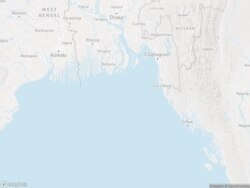
Foul weather friends
Even so, said Marston, Myanmar can still use India’s investment in the Kaladan project to hedge against China, being wary itself of relying too much on any one country, especially since the coup.
The junta’s brutal repression of a growing armed resistance has been whittling away at Myanmar’s foreign allies, yet India has held firm. Along with China and Russia, it abstained from a U.N. Security Council resolution in December calling for an immediate end to the violence. India is also one of the few countries still selling arms to Myanmar, though far less than China or Russia.
“The junta’s efforts ... aren’t doing much to win popular support in the country, but it’s looking to deepen its external partnerships, especially those that allow it to avoid relying too much on just China, especially in foreign investment,” Marston said.
Even with enough funding, though, finishing the Kaladan corridor will not be easy, the analysts said. Long-running insurgencies pockmark both sides of the border. Fighting has been especially intense on the Myanmar side since the coup.
Marston said the ongoing violence will be a “huge obstacle” to building the road meant to complete the corridor north of Sittwe.
“That road is not being built any time soon,” Paliwal agreed.
Banerjee said she is more optimistic, assuming the Myanmar junta’s efforts to strike a cease-fire with some of the country’s major rebel armies bear fruit and that India can cozy up to Myanmar’s opposition government in exile, which has close ties with some of the groups.
“If India is able to strike the right chords, I think there is a hope that it [the corridor] will be completed after a few years, but not right now,” she said.




